
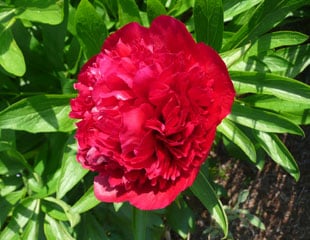
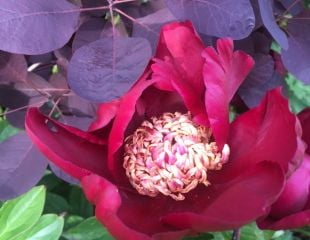
How to grow Peonies
Peonies are a clump forming herbaceous perennial which returns reliably each year. The most commonly grown Peonies flower in late spring and early summer, with large saucer like flowers, some with multiple ruffled petals and a central boss contrasting in white or yellow. Some peony varieties have a strong scent and produce multiple flowers. The downside to growing peony, possibly, is that the flowers are not the most long lasting and because the flower heads are so large, Peonies do require staking.
As a rule of thumb, the double white and pink Peonies are often scent whereas single and red varieties are not.
How to plant and care for Peony
Peonies need to be planted in a sunny spot with good humus rich, well-drained soil. Gardening advice often states Peony needs to be grown in Alkaline soil. Don't let this put you off I have successfully grown Peonies in acidic soil without any problem.
What is most important when planting a Peony is not to plant the crown too deep. The crown should be around 2.5 and 5 cms below soil level, so quite shallow. If you plant Peony tubers too deeply, they are likely to produce lots of foliage but not enough flowers. The planting depth is important: too deep and it will inhibit flowering. If you mulch, take care not to mulch over the crown.
If your peony isn't flowering, it could be that you planted it too shallow.
How and Why Stake a Peony
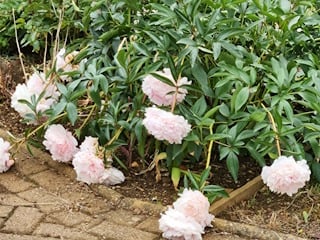
It's best if you have time to stake Peonies, and to do it early to let the plant grow into the support. This avoids the nerve-racking task of trying to thread leaves and flower stalks into the plant support without breaking anything. Peonies only flower the once, so if a flower head is snapped, it will not flower again. Depending on growing conditions, this means staking Peony around late March/early April. You can use custom made Peony supports such as the metal one illustrated below. You can move the support up the stake shaft as the plant grows, supporting the large blooms.
Alternatively, you can use organic material such as off cuts, branches, saved from pruning and these look natural, and are free. The video below shows How to Stake a Peony, and other perennials.
Peony blooms do not do well if there is heavy rain or winds. The image above shows a lovely Peony, with great blooms, but its totally fallen over after some wet, gusty summer weather. Staking, which supports the flower heads, can help to ameliorate the worst effects of weather. I have labelled Peony amber wheel barrow showing medium effort and maintenance. Peony is not fool-proof, but they return reliably every year.
At the end of the season, the foliage can look unsightly and it is best to cut it down. As a herbaceous perennial, Peonies die right back to bare earth in the winter; the emerging spring growth is attractive, see image below right.
Suttons have a lovely selection of Peony with many scented varieties- affiliate link.
Video How to Stake Peony (and other Perennials)
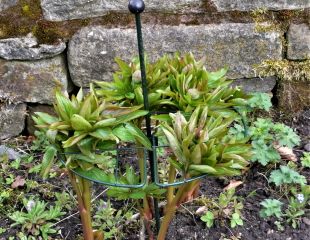
What is a tree Peony
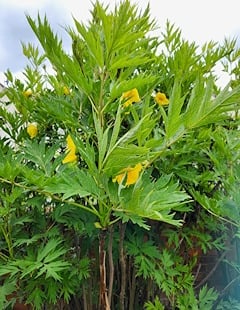
As the name suggests, Tree Peony is a small to medium-sized, deciduous shrub. Tree Peonies flower in May and June, but do not die back over winter. The Tree Peony will shed its leaves, but the branch framework will remain in place all winter.
Tree Peony will grow in sun or semishade. Tree Peonies are fully hardy, long lived shrubs which are best planted away from cold winds but are otherwise tolerant of most growing conditions.
Because many tree peonies are grafted onto rootstock, you need to locate the graft and plant it about 15 cm (6") below the soil surface when planting. You can find the graft by looking for a bulge close to the root and then ensure you plant it deep. Suttons have a good selection of Tree Peonies some of which are scented.
8 of the Best Peonies to Grow for Scent
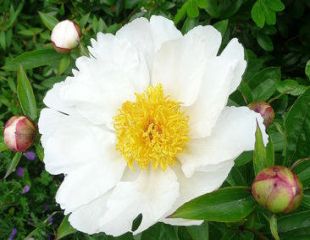
Many Peonies are wonderfully scented you just have to pick the right one. Mostly, it is the Peony lactiflora group which is scented.
Illustrated is P.'Miss America' which is strongly scented 2.P,'Mothers Choice' a blush coloured flower with good scent 3.P. 'Festiva Maxima' a white double flower with flecks of crimson
4. P 'Henry Bockstoce' bright red double flowers ( a lactiflora and officinalis cross)
5. P. 'Duchesse de Nemours' an old variety, lemony white flowers said to smell like lily of the valley
6. P. Hawaiian Coral'.
7.
Peony 'Sarah Bernhardt' is another old-fashioned very popular scented variety for sale at Suttons (affiliate link) has double flowers in soft pink.
8. P ‘Karl Rosenfield’ has large magenta blooms, yellow boss and good scent. These are just a few of the many varieties worth checking if you are looking for Scent.
How to move Peonies
It is said that Peonies dislike to be moved; I am not sure I agree. If you have planted a Peony in the wrong place, don't despair, move it. I have moved several peonies and here's how.
The best way to move a Peony is early in the season before the plant has developed too much leaf. Move it quickly, with plenty of the existing soil attached to the roots to cause as little disturbance as possible. Dig up the plant and keeping it as intact as possible and transfer straight away, re plant at the correct level and water well. You can also move in autumn.
The key to moving a Peony successfully is as little root disturbance as possible.
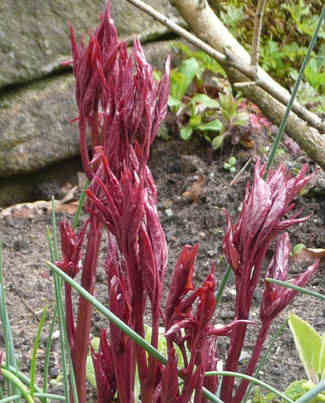
Peony Wilt
Peony Wilt is a disease specific to peonies, in a similar way to Clematis Wilt.
It is caused by Botrytis paeoniae, causing grey fuzzy fungal growth at the base, and looks like the grey mould typical of a Botrytis infection. Stems can wilt and wither. On the leaves, it can appear as brown patches.
Cut off all diseased parts, which may involve cutting the plant right back. Hygiene is the only defence, cutting and removing infected material especially around the base as the spores can lie dormant in the soil only to emerge next year. Clear away any leaves on the soil. Good air circulation can help so it is best not to plant too close together. There are no effective chemical controls. Fortunately, it's rare.
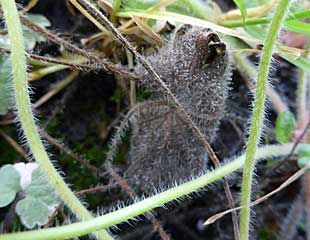

Peonies are of medium difficulty to grow, mainly they need to be planted to the correct depth, and they do need to be staked to support the flower heads.
